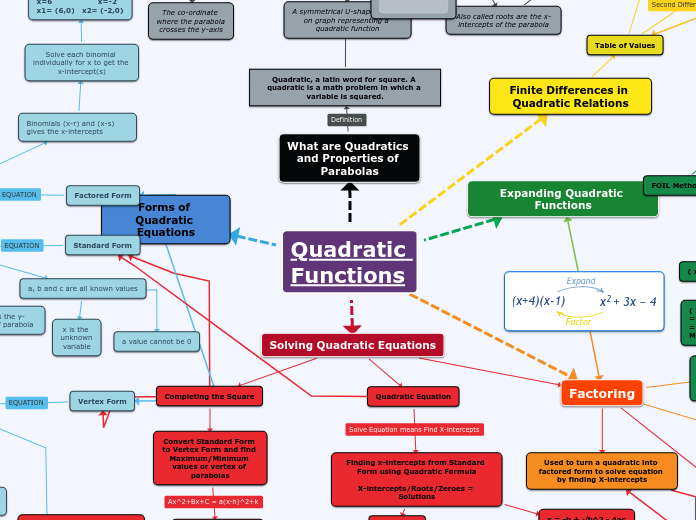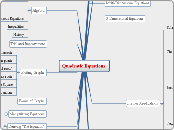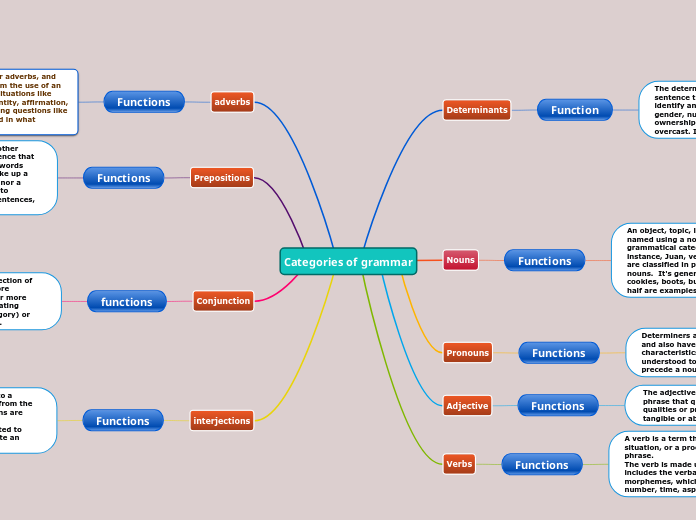FOIL Method
First Outside Inside Last
( x + 3 ) ( x + 2 )
= x^2 + 2x + 3x + 6
= x^2 + 5x + 6
Distributive Property
a(b + c)
= ab + ac
e.g.
2(x + 4)
= 2x + 8
( x + a ) ( x – a ) = x^2 – a^2
( x + 5 ) ( x – 5 )
= x^2 – 5x + 5x – 25
= x^2 – 25
Middle term cancel out
Sub. in x and a values to expand
x^2-5^2
=x^2-25
( x + a )^2 = x^2 + 2ax + a^2
( x – a )^2 = x^2 – 2ax + a^2
When the Binomial is square, to expand you must multiply the binomial by itself
2. Use FOIL Method
1. Get rid of the square sign and have the binomials multiply eachother
( x – 3 ) ( x – 3 )
( x + 5 )^2
= ( x + 5 ) ( x + 5 )
= x^2 + 10x + 25
Expanding Binomials
(a + b)(c + d)
= ac + ad + bc + bd
e.g. (x + 4)(x – 3)
= x^2 – 3x + 4x – 12
= x^2 + x – 12
a^2 - b^2 = (a+b)(a-b)
144p^2 - 81 = (12p+9)(12p-9)
(12p+9)(12p-9) is a factored difference of squares
2. Factor by Grouping (if necessary)
Group terms with common factors to solve
2x^2+6y+4x+3xy
=2x^2+4x+6y+3xy
=2x(x+2)+3y(2+x)
=(x+2)(2x+3y)
a = vertical stretch/compression factor
Use Step Pattern for plotting points of parabola
Step Pattern
--------------
1,3,5,7,9,....
Multiply a value and step pattern to get correct points of a given parabola
Ex. a=2 Step Pattern
=2[1,3,5,7,9]
=2,6,10, 14, 18
Direction of Opening
-----------------------
If a>0 it is upward opening parabola, if a<0 it is downward opening parabola
If -1 < a < 0 or 0 < a < 1, (a is a fraction)then the graph is compressed vertically
If a > 1 or a < -1, then the graph is stretched vertically by a
factor of a
Vertex
(h,k)
Vertex
---------------------------------------
(Axis of Symmetry, Optimal Value)
(x, y)
(2, -8)
Vertex Form
y = a(x-h)^2 + k
Base Parabola is
y=x^2
Sub in x=0 to find y-intercept
k = y value of the vertex
"k" value is added
"k" represents a vertical shift
If k>0, it is a vertical shift up by k units. If k<0, it is a vertical shift down by k units.
h = x value of the vertex and axis of symmetry
"h" value is subtracted
"h" represents a horizontal shift
If h>0, it is a horizontal shift to the right. If h<0, it is a horizontal shift to the left
Factored Form
y = a(x-r)(x-s)
Sub in x as 0 to find y-intercept
y=0.5(x-6)(x+2)
y=0.5(0-6)(0+2)
y=0.5(-6)(2)
y=0.5(-12)
y=(-6)
Y-intercept is (0,-6)
Sub in axis of symmetry as x value to find optimal value (y value of vertex)
y=0.5(x-6)(x+2)
y=0.5(2-6)(2+2)
y=0.5(-4)(4)
y=0.5(-16)
y=(-8)
Optimal Value of parabola
is -8, meaning the y-value
of the vertex is -8
Binomials (x-r) and (x-s) gives the x-intercepts
Solve each binomial individually for x to get the x-intercept(s)
y=0.5(x-6)(x+2)
--------------------------
x-6=0 x+2=0
x=6 x=-2
x1= (6,0) x2= (-2,0)
adding x-intercepts and then dividing by 2 = axis of symmetry - midpoint of x-intercepts
(6,0) and (-2,0)
------------------
=[6+(-2)]/2
=[4]/2
=2
Axis of Symmetry
is (2,0)
X value of vertex
is 2 - (2,y)=vertex
axis of symmetry is the x value of the vertex
Standard Form
y = ax^2 + bx + c
Formula for Axis of Symmetry
--------------------
x = -b/2a
y=0.5x^2-2x-6
a=0.5 b= -2 c= -6
x= 2/2(0.5)
x= 2/1
x= 2
c value is the y-intercept of parabola
a, b and c are all known values
x is the unknown variable
a value cannot be 0
If FD or SD are not constant, the relation is niether
If Second Differences are constant, there is a quadratic relation
Minimum point if the parabola opens
upward (point with lowest y-value)
Maximum point if the parabola opens downward (point with highest y-value)
Axis of symmetry on the x-axis is the x-value of the vertex
Optimal Value is the Y-Value of the vertex
Vertex
The point where the axis of symmetry and the parabola meet at its maximum or minimum value
Quadratic Functions
Expanding Quadratic Functions
Solving Quadratic Equations
Quadratic Equation
Finding x-intercepts from Standard Form using Quadratic Formula
X-intercepts/Roots/Zeroes = Solutions
(b^2-4ac)
Discriminant
Negative discriminant = no real roots
If discriminant is zero there is 1 root
Positive discriminant = 2 roots
x = -b ± √b^2 - 4ac
________________
2a
2=-3x^2+4x+2
1. Make sure L.S or R.S is equal to 0
0=-3x^2+4x+2
5. Solve for x2
4. Repeat except make the addition sign between -b and square root subtraction
3. Solve for x1
a=-3, b= 4, c= 2
2. Sub in a, b, and c values in formula
Completing the Square
Convert Standard Form to Vertex Form and find Maximum/Minimum values or vertex of parabolas
y=3x^2-12x-5
y=(3x^2-12x)-5
y=3(x^2-4x)-5
-4/2=-2^2=4
y=3(x^2-4x+4)-5
y=3(x^2-4x+4)-17
y=3(x-2)^2-17
8. Write out the final Equation that is left over
7. Keep the "a" value outside bracket and square root the first term x^2, keep the sign of the middle term (addition or subtraction) and square root the last term in bracket, add a square outside of end bracket to give you: (x-h)^2
5. Move the opposite sign (b/2)^2 value outside bracket by multiplying it by "a" value
6. Add this value with the k value outside bracket to get final k value
4. Add the opposite sign of the (b/2)^2 inside the bracket
EX. 2(x^2+6x+9-9)+11
3. Make Perfect Square Trinomial inside bracket using: (b/2)^2
2. Common Factor the "a" value
1. Put brackets around ax^2+bx terms
Vertex = (2,17) Minimum = -17
Factoring
Difference of Squares
a^2 - b^2 = (a+b)(a-b)
a^2 = 144p^2 so a = √144p2 = 12p
b^2 = 81 so b = √81 = 9
Sub. in a and b into reference equation to get factored
Ax^2+Bx+C
=144p^2+0x-81
=144p^2-81
=(12p+9)(12p-9)
Identifying Characteristics
Contains Perfect Squares
Contains a difference (Subtraction)
Contains Binomials (2-terms)
Perfect Square Trinomials
Same method of factoring is used as factoring trinomials except you write the product as the square of a binomial
First and last terms are perfect squares
a^2±2ab+b^2 = (a±b)^2
Check that "2ab" is the middle term
2ab = 2(2x)(3)
= 4x(3)
= 12x
Therefore, 2ab is the middle term and that means it is a square trinomial
Using this as a reference equation find out what a and b are
a^2 = 4x^2 so a=√4x^2 = 2x
b^2 = 9 so b=√9 = 3
4x^2+12x+9
4(9) = 36
m(n)=36 m = 6
n+n=12 n = 6
Sub. in numbers as bx term = 12x
=4x^2+6x+6x+9
=2x(2x+3)+3(2x+3)
=(2x+3)(2x+3)
=(2x+3)^2
6. The last two binomials should be the same and so you simplify them together by writing the product as the square of the binomial
E.g. (2x – 3)(2x – 3) = (2x – 3)^2
5. Group the terms with common factors and factor each binomial group
4. Substitute the two numbers for the middle term
3. Multiply a value and c value
-Find two numbers that multiply to the product of a(c) and have the sum of b
2. Move GCF outside of bracket
1. Factor out the GCF by dividing it with all terms
Finding what to multiply together to get an expression
Trinomial Standard Form
ax^2+bx+c
----------------------------
2x^2+10x-12
=2(x^2+5x-6)
=2(x^2-1x+6x-6)
=2(x(x-1)+ 6(x-1)
=2(x-1)(x+6)
x-1=0 x+6=0
x=1 x=-6
If the trinominal cannot be common factored and the a value is more than 1, you have to multiply a and c
m(n)=a(c)
m+n=b
4. Factor by grouping
3. Find Two integers that multiply to "c" and add to "b"
m*n=-6
m+n=-5
-1*6=-6
-1+6=5
Sub. in these numbers for b value
These two integers end up being (x-r) and (x-s) in factored form
1. Common Factor (If Any)
Common Factor = 2
Binomial Common Factor
2(x+1)-3y(x+1)
_____________
(x+1)
= (x+1)(2-3y)
Monomial Common Factor
12 x^2y-9x^3y^2z+18x^2y^2
_________________________
3x^2y
=3x^2y(4-3xyz+6y)
Divide each term by the GCF and write what remains in bracket
Move GCF outside of bracket
Identify greatest common factor = 3x^2y
Used to turn a quadratic into factored form to solve equation by finding X-intercepts
Finite Differences in Quadratic Relations
Table of Values
SD = Subtracting FD values
FD = Subtracting consecutive y-values
If First Differences are constant, there is a linear relation
What are Quadratics and Properties of Parabolas
Quadratic, a latin word for square. A quadratic is a math problem in which a variable is squared.
Parabola
Optimal Value
The lowest or highest value/peak or bottom of the parabola depending on the a value - UPWARD or DOWNWARD?
Y-intercept
The co-ordinate where the parabola crosses the y-axis
Axis of Symmetry
Axis of Symmetry is the sum of the roots divided by two
A vertical line that divides the parabola into two equal halves
Zeroes
Also called roots are the x-intercepts of the parabola
Can have one, two or zero roots
A symmetrical U-shaped curve on graph representing a quadratic function
Forms of Quadratic Equations









